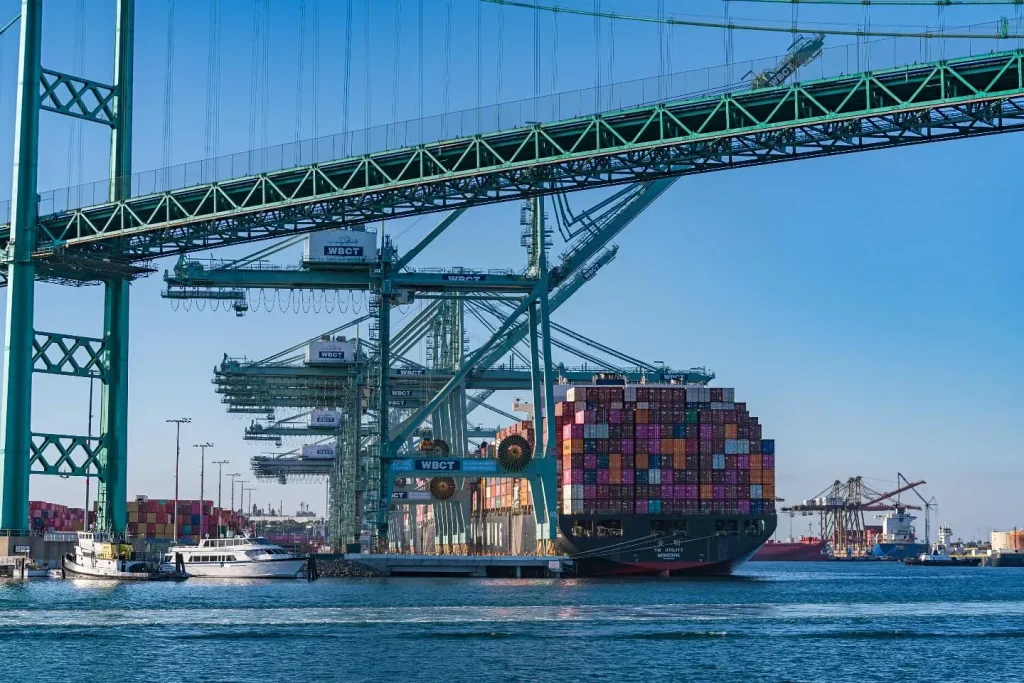Tariffs impact on Port of Los Angeles is reshaping the regional economy as officials report fewer jobs and slower trade flows. Local reports describe ongoing job reductions for longshoremen and related workers at the port in 2025. In May, cargo moved 25% less than forecast, and 733 job orders over 25 shifts illustrate the shrinking opportunities for dockworkers and truckers. Trump tariffs impact on shipping have throttled the flow of goods into Southern California, contributing to a noticeable decline in regional cargo activity. The broader ripple effects threaten local retailers, transit routes, and the region’s logistics ecosystem, with tighter margins and slower turnaround times for businesses that rely on overseas supply.
Beyond the headlines, the issue is really about how duties alter the cost of goods and the rhythm of global supply chains. Customs duties and related tax measures re-price imports, affecting pricing, planning, and profitability for manufacturers, shippers, and logistics providers. West Coast cargo volumes and terminal operations are adjusting capacity, schedules, and trucking patterns as demand cools. Analysts track throughput, port-related employment data, and consumer price shifts to map the broader economic footprint.
Tariffs impact on Port of Los Angeles
Tariffs have reshaped the tempo of trade at the Port of Los Angeles, slowing shipments and reducing dockside activity. With the new duties in place, fewer goods are moving through the harbor, triggering a pullback in hiring and a tightening of schedules for longshore workers. Port leadership warns that the tariffs are not just a policy line on a page but a practical drag on the regional economy, especially for the logistics and trucking sectors. The headline effect has been a marked drop in cargo activity, contributing to what experts describe as the ongoing Port of Los Angeles job losses 2025.
Retailers and manufacturers report higher costs and longer lead times as the Trump tariffs impact on shipping becomes more evident. The slowdown is visible in the numbers: May saw 25% less cargo than forecast, and several cargo ships canceled planned trips to Los Angeles. The broader ripple effects stretch through the LA-LB region, with fewer jobs and tighter schedules for port-related workers. Imported goods face higher import costs due to tariffs, reshaping consumer prices and business planning across Southern California.
LA-LB port cargo volume decline and its ripple effects
Since tariffs began, the LA-LB port cargo volume decline has translated into fewer job opportunities for dockworkers, truckers, and warehouse staff. Terminal operators report a softer pace of arrivals and departures, complicating labor planning and shifting bid opportunities for longshoremen. The slowdown matters not just for the ports, but for a wider supply chain that depends on reliable cargo flows to meet holiday-season demand.
Analysts warn that a prolonged decline in cargo volumes could erase thousands of jobs indirectly, as warehouses and trucking firms scale back hours. The port’s ability to match schedules with demand is being tested, with fewer ships and a five- to ten-ship-per-day reduction compared with normal peaks. The LA-LB corridor remains the main gateway for trans-Pacific trade, and sustaining throughput is critical to avoid a broader economic downturn.
Port of Los Angeles job losses 2025
Many workers report reduced hours or shifts as cargo slows, pointing to a volatile labor market around the Port of Los Angeles. The port’s leadership has highlighted that nearly half of longshoremen have faced reduced work opportunities in recent weeks, signaling a worrying trend for local employment. The Port of Los Angeles job losses 2025 is resonant in policy discussions about regional resilience and workforce retraining.
Union officials and business groups are watching closely how activity rebound or further declines could reshape wages and hours. The job losses are not isolated to dock workers; truck drivers, warehouse staff, and related logistics teams are sharing the impact as demand weakens and inventories tighten. Stakeholders emphasize the need for diversified cargo streams and alternative routes to stabilize employment in coming months.
Trump tariffs impact on shipping
Experts note that the Trump tariffs impact on shipping has been to slow the global flow of goods, forcing rerouting and stockpiling strategies across major ports. Los Angeles and Long Beach have felt the pinch as imports shrink and shipping lines adjust schedules. The policy shift has forced carriers to reconsider capacity, premium surcharges, and lead times, affecting the bottom line for importers and exporters alike.
Small and mid-size businesses report higher landed costs and longer wait times, illustrating how tariffs reshape the economics of cross-border trade. The ripple effects touch trucking firms, warehouses, and intermodal operators, who must absorb shifts in demand and price. The broader implication is a shipping market recalibrating to higher costs and more uncertainty.
Tariffs effect on trucking industry
The tariffs effect on trucking industry has been pronounced as freight volumes dip and routes shift away from the Southern California hub. Trucking firms report reduced weekly hours, tighter margins, and bid cuts as shippers reprice moves to avoid tariff-impacted commodities. The port slowdown squeezes drivers’ schedules and pushes some fleets to seek work in alternative markets.
From a policy perspective, carriers are adapting by optimizing intermodal transfers and seeking relief from price volatility. The tariffs create a risk premium that shows up in fuel costs, tolls, and lane rate adjustments, complicating capacity planning for the trucking industry. Long-term, persistent tariff-induced uncertainty could accelerate a consolidation trend among small trucking outfits.
Import costs due to tariffs
Import costs due to tariffs are now a top consideration for retailers and manufacturers relying on Asia-Pacific and global supply chains. Companies are absorbing some duties, passing others to customers, and rethinking supplier diversification. The Port of Los Angeles remains a pivotal node, yet the tariff regime complicates pricing and inventory strategies.
Analysts point to broader consequences for inflation and consumer prices, with import costs due to tariffs contributing to higher costs in apparel, electronics, and home goods. The shipping backlog and reduced cargo volumes can also raise transit times, compromising just-in-time delivery. Stakeholders advocate for policy adjustments to restore predictability and support job growth at the port.
Community and small-business impacts around the harbor
Local restaurants, shops, and service providers near the harbor report softer foot traffic as port-related activity slows. The convergence of higher import costs and slower cargo flows reduces discretionary spending and customer visits to waterfront districts. Community leaders warn that the port’s health directly affects thousands of jobs across the harbor area, including small business owners.
Municipal and business groups are calling for targeted relief and retraining programs to shield workers whose hours have fallen. The connectivity between the port, the local economy, and regional tax receipts is clear, underscoring why a resilient port matters beyond trade numbers. Ongoing dialogue between policymakers, unions, and business associations aims to chart a path back to more robust regional activity.
Resilience strategies for the Port of Los Angeles
Port authorities are exploring resilience strategies to counteract tariff-driven demand swings, including diversifying cargo mix and pursuing alternative trade lanes. By expanding operating windows and improving berth productivity, the port can better absorb fluctuations caused by global policy shifts. The focus remains on sustaining jobs and maintaining critical supply-chain links for the region.
Investments in automation, workforce training, and digital transparency can help the Port of Los Angeles weather uncertainty. Industry partners emphasize collaboration with trucking firms and intermodal operators to optimize schedules and reduce dwell times. The aim is to cushion the labor market from shocks and to preserve important regional employment in the face of tariff cycles.
Schedules, vessels, and the pace of imports
Vessel calls and schedule reliability have become a barometer of port health as tariffs reshape import patterns. Fewer ships in port translates to longer wait times and adjustments to labor bid opportunities for longshoremen. The resulting cadence affects downstream logistics, including truck turns and warehouse slots across the LA-LB corridor.
Shippers are recalibrating inventory buffers and production calendars in response to volatile tariffs and policy changes. The port’s ability to maintain steady cargo flows is integral to the region’s economic momentum, and any improvement in schedule reliability could help restore confidence among retailers and manufacturers alike.
Policy responses and industry calls to action
Industry groups and local officials are urging policymakers to consider phased tariff policies and targeted exemptions to ease the burden on critical supply chains serving Southern California. The dialogue centers on balancing national trade goals with regional employment protection and price stability. Traders, unions, and logistics firms advocate for data-driven adjustments to minimize disruption.
Efforts to restore momentum include investment in port infrastructure, data-sharing platforms, and workforce retraining programs. By aligning policy with practical port operations, stakeholders hope to accelerate a return to healthier cargo volumes and more stable job opportunities at the Port of Los Angeles.
Long-term outlook for the port’s employment and growth
The long-term outlook for the port’s employment and growth depends on policy stability and the pace of global trade normalization. If tariff regimes ease or are refined, cargo volumes can rebound and job opportunities may recover with new training paths for affected workers. The Port of Los Angeles remains a critical economic engine for the region, with capacity to adapt to evolving trade patterns.
Strategic planning emphasizes resilience, supply-chain diversification, and investment in technology and workforce development. With ongoing attention to tariffs and their impacts, the port can strive to rebuild confidence among workers, carriers, and local businesses while supporting sustainable growth in the LA-LB port complex.
Frequently Asked Questions
Tariffs impact on Port of Los Angeles 2025: What is happening to job opportunities?
The Tariffs impact on Port of Los Angeles in 2025 shows dwindling job opportunities as tariffs affect global trade. Nearly half of longshoremen have gone without work in the last two weeks, and only 733 job orders were posted across 25 shifts—well below typical levels of 1,700–2,000 for a day shift and 1,100–1,400 for a night shift. May cargo was about 25% below forecast, reflecting tariff‑driven declines in activity.
Trump tariffs impact on shipping and the Port of Los Angeles: how is cargo volume affected at LA-LB?
Trump tariffs impact on shipping has slowed the flow of goods through the Port of Los Angeles and Long Beach. This has contributed to a LA–LB port cargo volume decline, with May cargo processing about 18% lower than the prior month, and 17 planned cargo ship departures canceled as the tariff environment creates uncertainty for importers.
LA-LB port cargo volume decline due to tariffs impact on Port of Los Angeles: what does it mean for jobs?
The LA-LB port cargo volume decline tied to tariffs directly threatens local jobs. A 1% drop in cargo could wipe out about 2,769 jobs and endanger as many as 4,000 more. By contrast, the ports historically support tens of thousands of jobs directly and indirectly, including dockworkers, truckers, and logistics staff.
Tariffs effect on trucking industry tied to Port of Los Angeles: what should we expect?
Tariffs effect on trucking industry is evident as cargo slows and yard/workforce needs shrink. With reduced cargo, longshoremen’s hours can fall (some workers not receiving full 40 hours), and trucking and warehouse roles feel the impact as demand for transportation services declines alongside freight volumes.
Import costs due to tariffs and the Port of Los Angeles: how are consumers affected?
Import costs due to tariffs raise prices for a broad range of goods, including groceries, clothing, and cars. When tariffs slow shipments or raise sourcing costs, shelves can empty sooner and consumer prices rise, impacting households and overall local demand around the Port of Los Angeles.
Tariffs impact on Port of Los Angeles through May 2025: what are the latest indicators?
Through May 2025, indicators point to a continued tariff‑driven slowdown: May cargo fell 18% from the prior month, 17 cargo ships canceled trips to LA, and overall cargo volume was about 25% below May forecasts. Daily ship traffic has decreased, with roughly five ships entering the port per day, down from typical levels of 10–12.
LA-LB port cargo volume decline and the Tariffs impact on Port of Los Angeles: what is the near‑term outlook?
The near‑term outlook suggests conditions are unlikely to improve quickly. June projections are not expected to match traditional activity, and ongoing tariff uncertainty is expected to keep cargo volumes and related job opportunities subdued at the Port of Los Angeles and the LA–LB complex.
Broader economic effects of Tariffs impact on Port of Los Angeles: what else is happening?
Beyond port operations, tariffs ripple through the regional economy. A 2023 study showed the LA and Long Beach ports contributed $21.8 billion in direct revenue to local service providers, generated $2.7 billion in state and local taxes, and supported 165,462 jobs. Even a modest 1% cargo decline could trigger substantial job losses and broader economic stress in the surrounding area.
| Key Point | Details | Impact / Data |
|---|---|---|
| Tariffs slow trade and cargo flow | Trump’s tariffs have slowed the flow of goods into the U.S., reducing activity at LA and Long Beach ports. | May cargo processed 25% less than forecast; neighboring ports affected |
| Employment impact on longshoremen | Nearly half of the longshoremen supporting port operations were without work over the last two weeks. | Significant underemployment among dock workers |
| May performance and ship activity | 17 cargo ships canceled their planned trips to Los Angeles in May; May showed 18% less cargo processed than the prior month. | Lower throughput and shipping disruptions |
| Job orders and opportunities | Marine terminal operators post job orders three times daily; last 25 shifts averaged 733 orders vs typical 1,700–2,000 (day) or 1,100–1,400 (night). | Fewer opportunities; risk of unpaid time when orders exceed workers |
| Broader economic ripple | A 2023 study found LA/Long Beach ports contributed $21.8B in direct revenue, $2.7B in taxes, and 165,462 jobs; a 1% cargo drop could wipe out 2,769 jobs and endanger up to 4,000 more. | Significant regional economic exposure to port activity |
| Industry warnings and consumer impact | U.S. representatives warn tariffs may lead to higher prices and broader job losses across supply chains. | Potential price increases and employment effects across related sectors |
Summary
The table above summarizes the key points from the base content about tariffs and the Port of Los Angeles. It highlights how tariffs have slowed cargo flow, reduced employment for longshoremen, disrupted May activity, lowered job opportunities, and produced ripple effects across the broader LA economy.



